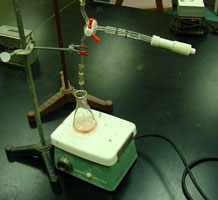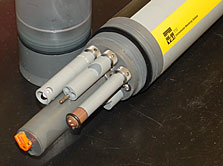2. How do we measure dissolved oxygen?
Dissolved oxygen is measured two different ways. The first method is the Winkler titration, a chemical measurement of dissolved oxygen. The Winkler titration has been used for a long time and can give very good results if done carefully. Field test kits are based on the Winkler titration.

Set-up for a Winkler Titration
(Click for larger image)
The second method is using an electronic oxygen meter. The oxygen meter is generally fairly expensive (several hundred dollars) and requires proper care and calibration. Oxygen meters give good results and are often the best option for looking through the water column and continuous measurements. Oxygen meters are commonly used on research buoys and oceanographic research vessels.
 |
Sensors used on the RI/MA EMPACT Buoys. If you were looking straight at the end on the instrument, the probe in the 3 o'clock position with the brown end is an oxygen sensor.
(Click for larger image) |
For further explanation of the Winkler titration see the web page:
<http://water.usgs.gov/owq/FieldManual/Chapter6/6.2.1.html#HDR6.2.1.CAL4>
For further explanation of how an oxygen meter works see this web site:
<http://www.vernier.com/probes/do.html>
| 


